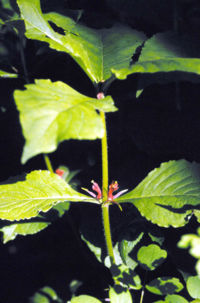Triosteum
| Standard Cyclopedia of Horticulture |
|---|
|
Triosteum (name shortened by Linnaeus from Triosteospermum, which is from Greek for three bony seeds). Caprifoliaceae , Feverwort. Horse Gentian. Coarse hardy perennial herbs, glabrous or glandular-pilose: sts. rather simple, terete: lvs. opposite, sessile, rather fiddle-shaped or obovate, entire: fls. usually axillary, solitary or clustered, dirty white, yellow, or purple; calyx-tube ovoid, limb 5-lobed, persistent; corolla tubular-campanulate, base of tube gibbous, limb oblique, lobes unequal; stamens 5; disk small, swollen; ovary 3-5-celled: berry fleshy or leathery, 2 (rarely 3-5)-celled, 2-3-seeded. — About 8 species, N. Amer., Himalayas, and China.
|
| Triosetum {{{status}}} Fossil range: {{{fossil_range}}}
| ||||||||||||||||||||||||||||||||||||||||||||||||||||||||||||||||||
|---|---|---|---|---|---|---|---|---|---|---|---|---|---|---|---|---|---|---|---|---|---|---|---|---|---|---|---|---|---|---|---|---|---|---|---|---|---|---|---|---|---|---|---|---|---|---|---|---|---|---|---|---|---|---|---|---|---|---|---|---|---|---|---|---|---|---|
 Triosteum perfoliatum | ||||||||||||||||||||||||||||||||||||||||||||||||||||||||||||||||||
| Plant Info | ||||||||||||||||||||||||||||||||||||||||||||||||||||||||||||||||||
| ||||||||||||||||||||||||||||||||||||||||||||||||||||||||||||||||||
| Scientific classification | ||||||||||||||||||||||||||||||||||||||||||||||||||||||||||||||||||
| ||||||||||||||||||||||||||||||||||||||||||||||||||||||||||||||||||
| [[{{{diversity_link}}}|Diversity]] | ||||||||||||||||||||||||||||||||||||||||||||||||||||||||||||||||||
| {{{diversity}}} | ||||||||||||||||||||||||||||||||||||||||||||||||||||||||||||||||||
| Binomial name | ||||||||||||||||||||||||||||||||||||||||||||||||||||||||||||||||||
| {{{binomial}}} | ||||||||||||||||||||||||||||||||||||||||||||||||||||||||||||||||||
| Trinomial name | ||||||||||||||||||||||||||||||||||||||||||||||||||||||||||||||||||
| {{{trinomial}}} | ||||||||||||||||||||||||||||||||||||||||||||||||||||||||||||||||||
| Type Species | ||||||||||||||||||||||||||||||||||||||||||||||||||||||||||||||||||
| {{{type_species}}} | ||||||||||||||||||||||||||||||||||||||||||||||||||||||||||||||||||
| {{{subdivision_ranks}}} | ||||||||||||||||||||||||||||||||||||||||||||||||||||||||||||||||||
| [[Image:{{{range_map}}}|{{{range_map_width}}}|]] | ||||||||||||||||||||||||||||||||||||||||||||||||||||||||||||||||||
| Synonyms | ||||||||||||||||||||||||||||||||||||||||||||||||||||||||||||||||||
| {{{synonyms}}} |
Triosteum, commonly known as horse gentian or, less commonly, feverwort, is a genus of flowering plant which includes six species. It is in the Caprifoliaceae family.
It is a perennial plant which has an erect, round, hairy, fistular stem, 1 to 4 feet (0.3 to 1.2m) high, opposite ovate-lanceolate entire leaves, and axillary whorls of brownish-purplish flowers. It is a native of North America, occurring in rich woods from Canada to Alabama and west to Iowa. Its dried and roasted berries have been occasionally used as a substitute for coffee; but it is chiefly valued for its medicinal properties, its root acting as an emetic and mild cathartic. It is sometimes called Tinker's root, being named after Dr. Tinker, who first brought it to notice.[1]